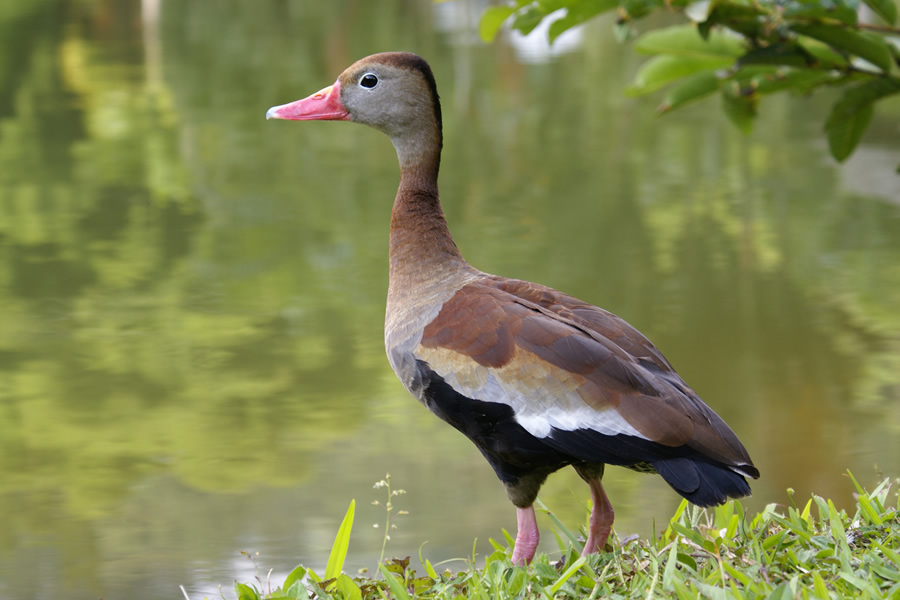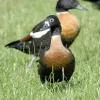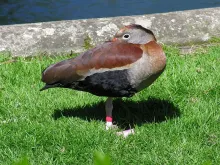
Black bellied Whistling duck (Dendrocygna autumnalis)
Species name
- Dutch name:
- Roodbek fluiteend
- English name:
- Black bellied Whistling duck
- German name:
- Rotschnabel Pfeifgans
- French name:
- Dendrocygne
- Scientific name:
- Dendrocygna autumnalis
Scientific classification
- Order:
- Anseriformes
- Family:
- Anatidae
- Onderfamilie:
- Dendrocygninae
- Genus:
- Dendrocygna
Description
- Description:
Male:
Head and upper neck are grey. Crown is dark brown. We can see a dark vertical hind neck stripe. Lower neck and chest are tawny-brown. Upperparts are tawny-brown to brown-cinnamon(D.a. discolor). (Breast and lower neck more grey brown and back more grey brown). Turning black on rump and uppertail coverts. Underparts are paler. It has black belly and flanks. Undertail coverts are mottled black and white. Upper wings show a broad white stripe, conspicuous in flight. When in flight, and the large white wing patch Flight feathers are black. Underwings are blackish. Bill is bright pink-red, often yellowish at base. Eyes are dark brown, with conspicuous white eye ring. Legs and webbed feet are bright pinkish-red.Female:
Identical to male. Duller and slightly smaller best if paired to tell the differences.Juvenile:
Duller and less well-patterned then adults, with gray -white belly marked with ill-defined darker cross barring; sooty-brown belly and flanks.
White of wing -converts pale gray- white and so less obvious in flight. Bill legs, feet mainly grey, tinged with pink or yellow. It reaches its adult plumage at 8 months of age. Very young birds have very paler belly, with indistinct transversal bars.
- Behaviour:
The black-bellied whistling duck is quite unique among ducks in their strong monogamous pair-bond. Nest in loose groups. Form compact flocks and sometimes large flocks of thousands of birds.
Standard Measurements
- Body Length (cm):
- The male (drake) of the Black bellied Whistling duck measures approximately 47-57 centimeters. The female measures approximately 46-55 centimeters.
- Body Weight (grams):
- The male will weight about 815-995 gram. The female will weight about 815-995 gram.
The weight is notoriously variable and can only be used as indication!
- Subspecies:
There are two subspecies:
- Northern black-bellied whistling duck - D. a. fulgens – Larger, with a brown breast and upper back.
- Southern black-bellied whistling duck - D. a. autumnalis – Smaller, with gray breast and upper back.
- Note:
Whistling-ducks generally do well, either in pens or in a park with access to extensive water area and good natural cover. They are gregarious outside the breeding season, and groups may bully smaller duck species, so should be kept in large areas, in which other birds have room to escape. Most need shelter in severe weather and a well-sheltered pen with frost-free night quarters for winter is suggested, or plenty of ground cover and/or straw to stand on, as they are susceptible to frostbite. They may be kept fully-flighted in aviaries, and have also been kept full-winged in open pens, tending not to wander. Perches should be provided at an appropriate height for pinioned or wing-clipped birds. Commercial pellets and grain are suitable for feeding.
Elevated nest boxes are appreciated by most species, although pinioned birds will use ground-level boxes; boxes may be placed over water or land. Eggs may be incubated by bantams and ducklings may be bantam-reared. Many species have been successfully parent-reared in captivity. Pairs kept isolated and fully flighted in a covered pen, with high-hung nest boxes "seldom fail to rear broods". Whistling-duck species may hybridise with one another and therefore should be kept in separate enclosures, and hybridisation has also occasionally been reported with Rosy-billed pochard (Netta peposaca).
Black-bellied whistling-ducks are relatively common in collections, easy to keep and attractive in mixed collections. Plentiful water, area for seclusion and opportunities for perching should be provided. They may be housed on ponds with other ducks - they are generally peacable and may be kept with small and delicate species, although they may squabble and chase each other, therefore should be provided with ample space. These ducks are quite sensitive to cold - more than are e.g. West Indian whistling duck (Dendrocygna arborea) or Fulvous whistling duck (Dendrocygna bicolor). Shelter should be provided for cold spring and autumn weather, with frost-free winter accommodation. May be fed wheat, standard pellets, together with greenfood such as lettuce, duckweed, grass, and bread.
These ducks are easily bred, and nest in dense cover near water, or may also use a hollow tree or a ground-level or raised nest box. The southern sub-species usually starts laying in April, but possibly late March, while the northern subspecies usually lay from mid-May onwards; usually lay April to June. Best results may be obtained if they are parent incubated and reared, although incubators or broodies may also be used. Downies require more warmth than most species, and should be given dry, drought-free accomodation. They should be offered food in a trough of water, to be sieved: fine floating vegetable matter, shrimp meal and duckweed are suggested, also fine-chopped hard-boiled egg in addition to duck-rearing meal. Newly hatched ducklings not being parent reared may easily drown if given free access to water in the first few days.
N.B. Communal nesting is not uncommon, with 25-50 eggs frequently found in one nest; these may be incubated naturally, but for increased hatching success some of the eggs should be removed and placed under bantams or in an incubator.
This species may hybridise with White-faced whistling duck (Dendrocygna viduata), West Indian whistling duck (Dendrocygna arborea), Fulvous whistling duck (Dendrocygna bicolor), Plumed whistling duck (Dendrocygna eytoni); the two subspecies should be kept separately to avoid sub-specific hybridisation.
- Breeding:
- The female Black bellied Whistling duck usually lays from 8-15 creamy white and not shiny eggs and incubates them for 26-31 days.
- Artificial incubating:
The ideal relative humidity for incubating most waterfowl eggs is 55% (ground nesters) and 40% (cavity nesters). The temperature is usually 37.4°C. Set ventilation as recommended by the incubator manufacturer. Eggs must be turned, either automatically or by hand, a minimum of 4 times a day. As the duckling develops there is a loss of water from the egg and the air sac gets bigger. In normal development of an egg with a 26-31 days incubation, the air sac occupies about a third of it three days earlier. Cleanliness is vital and ideally eggs should be moved to a separate hatcher at this point, where the humidity should be increased to 65% and even higher once they have pipped internally.
- Bird banding:
- Recommended closed leg band ring size for the Black bellied Whistling duck is 12 mm.The leg band ring can only be applied on a young whistling duck at around 12-14 days old.
- It doesn't matter what leg that you band, but it's good to have a consistent system. Suggested: Left leg = Female, Right leg = Male
- Maintenance food:
-





Floating full food for all sea ducks, green ducks, eider ducks and geese, especially in the moulting and breeding phase ideally suited. Packed with wholesome raw materials, natural vitamins and trace elements, this performance food with a protein content of 30% forms the basis for lifelong vitality.



